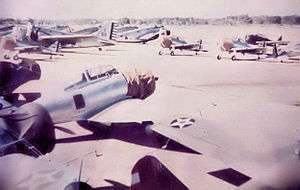Del Carmen Airfield
Del Carmen Airfield.svg.png) | |
|---|---|
| Part of Fifth Air Force | |
| Luzon, Philippines | |
|
P-35's at Del Carmen field, 1941 | |
| Coordinates | 08°21′41.59″N 124°49′59.97″E / 8.3615528°N 124.8333250°ECoordinates: 08°21′41.59″N 124°49′59.97″E / 8.3615528°N 124.8333250°E |
| Type | Military airfield |
| Site information | |
| Controlled by | United States Army Air Forces |
| Site history | |
| Built | 1930s |
| In use |
1940–1941 (Occupied by the Japanese, December 1941 – January 1945) |
| Battles/wars |
Battle of the Philippines (1942) Philippines Campaign (1944–45) |
Del Carmen Airfield is a former United States Army Air Forces airfield on Luzon in the Philippines. It was overrun by the Imperial Japanese Army during the Battle of the Philippines (1942).
History
The airfield was built by the Americans prior to World War II. It was located to the south of Clark Field in Pampanga Province. The Fifth Air Force based Seversky P-35As assigned to the 34th Pursuit Squadron, attached to the 24th Pursuit Group at the airfield prior to the Japanese air attack on the Philippines, 8 December 1941.
On the day of the first attack by Japanese aircraft, fighters were ordered from Del Carmen to cover Clark Field but failed to arrive before the Japanese hit Clark shortly after 1200 hours. The obsolescent P-35s were blown out of the sky by the Japanese Zeros, which were much faster and more maneuverable. The airfield was abandoned by the USAAF about 20 December prior to it being overrun by the invading Imperial Japanese Army. After its occupation, it was used by Japanese aircraft as a satellite field for the Clark area.
After the recapture of Luzon during the Philippines Campaign (1944–45), the airfield was not used by the USAAF. It was, however, the scene of a Japanese attack on 7 December 1944 when Japanese General Yamashita ordered the entire First Airborne Brigade with two regiments to jump the American beachhead on Leyte on 6 December. Japanese paratroopers loaded into 95th Sentai Ki-49 Helens and Ki-57 Topsys. They took off from Angeles South Airfield and Del Carmen Airfield. For the paratrooper drop and crash landings against the American liberated San Pablo Airfield and Buri Airfieldat 1800 hours. Although the paratroopers caught the Americans by surprise, those who did reach the airfields were ineffective. The attack proved to be disorganized and an abortive effort.
See also
- Geography of the Philippines
- Military History of the Philippines
- Military History of the United States
- United States Army Air Forces in the South West Pacific Theatre
References
![]() This article incorporates public domain material from the Air Force Historical Research Agency website http://www.afhra.af.mil/.
This article incorporates public domain material from the Air Force Historical Research Agency website http://www.afhra.af.mil/.
- Maurer, Maurer (1983). Air Force Combat Units Of World War II. Maxwell AFB, Alabama: Office of Air Force History. ISBN 0-89201-092-4.
- Maurer, Maurer, ed. (1982) [1969]. Combat Squadrons of the Air Force, World War II (PDF) (reprint ed.). Washington, DC: Office of Air Force History. ISBN 0-405-12194-6. LCCN 70605402. OCLC 72556.
- The Army Air Forces in World War II, Chapter 6, Pearl Harbor and Clark Field
